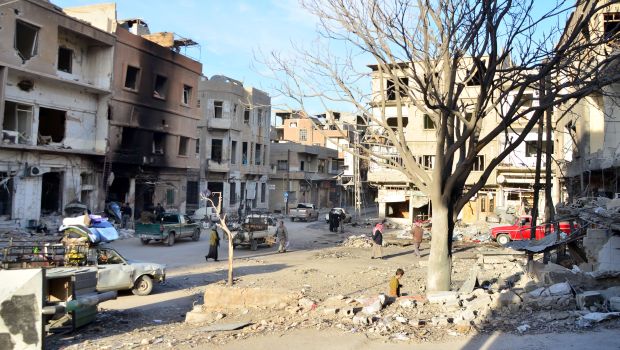
People walk in a street where building are damaged on February 21, 2014 on the key rebel-held bastion of Yabroud north of Damascus, as clashes also raged on the capital’s outskirts. (AFP Photo/Ali diab)
The clashes coincided with battles in Aleppo and Deir Ezzor, while fighting continued between the People’s Protection Units (YPG) and the Islamic State of Iraq and Syria (ISIS) in Tel Abyad, in northeastern Syria.
Activists said on Sunday that two surface-to-surface missiles hit the town of Yabroud, with one hitting the town center near the Al-Qaa district, and the other landing in the Al-Aqaba district. The industrial city has previously been the site of attacks by “barrel bombs” dropped by Syrian military helicopters.
A member of the Syrian rebel military council in the Rif Dimashq area, Isma’il Al-Darani, told Asharq Al-Awsat that the bombardment could be a “softening-up” campaign to prepare the way for another attempt by government troops to seize the town, one of the last rebel strongholds in the Qalamoun mountains.
He said: “[The attacks have] increased substantially in what seems like preparation for an invasion of the town and the surrounding areas where the opposition are based . . . the bombardment was carried out by rocket launchers and heavy artillery, in the absence of the air force.”
Activists said the absence of the air force from Sunday’s battle—after it had previously carried out 70 sorties in 48 hours—was due to weather conditions and the closeness of the positions of opposition and government forces, especially in the Sahel and Rima areas.
Darani said: “The bombardment came after constant attacks on the area by government forces and Lebanese Hezbollah fighters failed to achieve any results.”
Syrian activists claimed that the opposition had managed to shoot down two aircraft and destroy at least five armored vehicles in the 48 hours before Sunday’s bombardment.
Activist Amer Al-Qalamouni told Asharq Al-Awsat that Syrian government forces had been reinforced by members of an Iraqi militia.
He said: “[The] Iraqi Badr Brigade militia recently joined the government forces which suffered severe losses, while fighting continued to stop the government forces advancing to control the area.”
Opposition websites published names of what they said were Hezbollah and Badr Brigade fighters killed during clashes in Yabroud. The sources confirmed the death of a Hezbollah leader, Zuhair Abu Rafea.
The areas of Sahal and Rima north of Yabroud, along the Damascus-Homs highway, have seen heavy clashes between rebels and government forces, with the latter attempting to seize positions in the mountainous terrain along the Lebanese border.
Opposition forces responded to the bombardment by firing locally made missiles at the Nasseriya and Damir military airports in Rif Dimashq, and at the Qatifah military region.
Darani said: “Qatifah has been targeted for the first time since the start of the battles around Rif Dimashq,” adding that it was a “military garrison for the largest military divisions in the central region between Damascus and Homs, and includes residential homes for senior military officers.”
A number of mortars landed in the area of Abbasiyeen in Damascus, according to Local Coordination Council reports which said the Free Syrian Army destroyed a building used by government forces in the Jouber area of Damascus.
Areas in Harasta also received mortar strikes from government forces. The Syrian Observatory for Human Rights (SOHR) said clashes erupted between armed factions and government forces around the southern area of Zamalka and the Drousha front in western Ghouta.
In Idlib, the Syrian air force launched air raids on the Kafr Takharim town on the Turkish border, killing 13 people and destroying residential homes in the area.
Meanwhile, clashes continued around Aleppo between government and opposition forces. The most violent took place in the Sheikh Najjar district where activists said government forces tried to regain control. Activists said there were more clashes in areas inside Aleppo, including Marjah, Duwar Al Majdal and Al Kalasah. More sporadic clashes erupted in the southern suburbs of Aleppo, including Khanaser, where the opposition destroyed a government checkpoint.
SOHR said there were renewed clashes between armed factions and government forces near the area of Bani Yazid, while rockets hit the Masharqah area, which is under government control.
The area around the Central Aleppo Prison also came under government fire at the same time of clashes between the Al-Nusra Front and Ahrar Al-Sham Islamist movement on one side, and government forces on the other.
The Syrian air force continued to target Aleppo districts with barrel bombs, especially the district of the Sheikh Najjar Industrial City and Hananou residential district, as well as attacking El Bab, Haydariyah, Jazmati and Jabal Badr with more than eight missiles.
In a related issue, activists said ISIS had fortified the areas under its control in the El Bab area, 18 miles east of Aleppo, by erecting cement blocks and building roadside sand berms.
ISIS has been facing another challenge in Hasakah Governorate, where SOHR said ISIS clashed with Kurdish Democratic Union Party units in the western suburbs of Tel Abyad.
